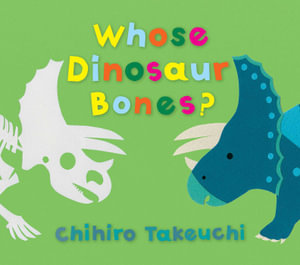Whose dinosaur bones? by Chihiro Takeuchi

The author of Whose bones? takes the young reader on another interactive journey of discovery as they look at dinosaur bones, footprints, and favourite food to try and work out what dinosaur it is.
The front cover will immediately intrigue lovers of dinosaurs with its skeleton of a Triceratops facing a paper cut out of the dinosaur, and then looking at the back cover the reader is confronted with the skeleton and picture of an Ankylosaurus. The books follows this format: the question 'Whose dinosaur bones?' is asked on a page with footprints and food, and the opposite page shows the dinosaur bones jumbled up. Then on the next double page is a picture of the skeleton of the dinosaur and its name and illustration. For example, on the first page the reader is asked 'Whose dinosaur bones?' and confronted with footprints, food, and mixed-up skeleton bones, making them use their knowledge of dinosaurs to put together the puzzle. Turning the page, the reader sees the skeleton of Triceratops and facing it is a picture of the Triceratops. Children must guess an Ankylosaurus, Stegosaurus, Velociraptor, Mosasaurus, and Tyrannosaurus. Then at the end are the skeletons of a Spinosaurus, Allosaurus, Brachiosaurus and a Parasaurus. The Fun facts double page spread will provide readers with some interesting and unusual facts.
The design of Whose dinosaur bones? is wonderful. It is a sturdy book with fabulous illustrations. The endpapers are intriguing with tiny dinosaurs popping out of their eggs and will provide a discussion point about how dinosaurs are hatched. The illustrations bring the dinosaurs to life. Bright coloured backgrounds make the cut outs of the skeletons, and the pictures of the dinosaurs stand out.
Even very young children who are obsessed with dinosaurs can name many of them and they certainly will enjoy guessing which bones belong to what dinosaur. The straightforward text, bright colours and interactive nature of this book make it an excellent vehicle to encourage curiosity, problem solving and an interest in nature.
Themes: Dinosaurs, Skeletons, Problem solving.
Pat Pledger